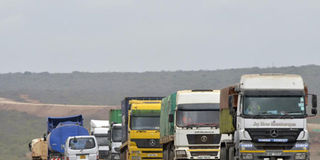High freight and storage costs hurting regional trade, say shippers

Trucks at Man Eaters along Mombasa-Nairobi Highway on February 20, 2015. The Government has identified 22 locations along the Northern corridor to build roadside stations for heavy commercial vehicles. PHOTO | FILE
What you need to know:
- According to the Pilot logistics survey report, most companies have not implemented a fully integrated logistics system. The firms mostly focus more on third-party agencies to run their transportation and warehousing necessities.
- Mr Langat, has also warned traders of the existence of people who would want to fight the new changes in cargo processing that are put in place to bring down costs and improve efficiency.
A new report has cited high freight and storage costs as the main challenges facing traders in the East African Community.
An audit conducted by the Shippers Council of Eastern Africa (SCEA) on companies drawn from a cross-section of segments has revealed where the traders go wrong in logistics leading them to incur huge losses that could otherwise be easily avoided.
This, according to regional traders, is making their products compete unfavourably in the market.
Logistics
According to the Pilot logistics survey report, most companies have not implemented a fully integrated logistics system. The firms mostly focus more on third-party agencies to run their transportation and warehousing necessities.
“The practice by most organisations is procuring imported goods on cost and freight (DFR) terms thus risking paying uncompetitive rates on sea and airfreight services,” the report states.
SCEA chief executive Mr Gilbert Langat said it is possible to cut freight costs by half if things are done in the right way.
EXORBITANT PRICES
“Lack of information on how to process cargo through the borders has seen middlemen take advantage of that and charge exorbitant prices to the company for processing the various documents — costs that could otherwise be avoided,” Mr Langat said.
“Storage is still very expensive for shippers in the region; it accounts for approximately Sh1.8 Billion in 2013/2014. If we reduce the cost by 20 per cent we would see significant changes in prices.”
Vivo Energy Kenya’s managing director, Mr Polycarp Igathe said the Kenya Revenue Authority’s delays in remitting the import duty also plays a role in the high costs of doing business in East Africa.
“Give back our drawbacks, there are certain importers who pay things that are not dutiable. To just get your duty drawbacks, should be an automatic system. And those are the big frustrations, they are increasing costs because what some people have tended to do is if I cannot get my drawback, I just charge it into the end consumer price,” said Mr Igathe.
Mr Langat, has also warned traders of the existence of people who would want to fight the new changes in cargo processing that are put in place to bring down costs and improve efficiency.
“There are people who are benefiting from inefficiencies in demurrage and storage, there are others who benefit from going round the system, and when we get everything done in a straightforward manner, of course some of these people will lose business,” he said.
BEST PRACTISES
Mr Langat therefore has urged regional shippers to equip themselves with all the necessary information that regards clearing of cargo at the ports to avoid paying extra for ‘services’ that are not necessary.
The report also recommends use of ICT where firms can use vehicle tracking systems and interactive websites where clients can download cargo status reports.
The study has also emphasized on the need for companies to audit their contracted transporters to establish their performance against the best practice of 9,000-12000 kilometers truck turnaround time per annum.
A World Bank report estimates that transport and logistics costs accounted for approximately 42 per cent of the total value of goods imported into the region.





